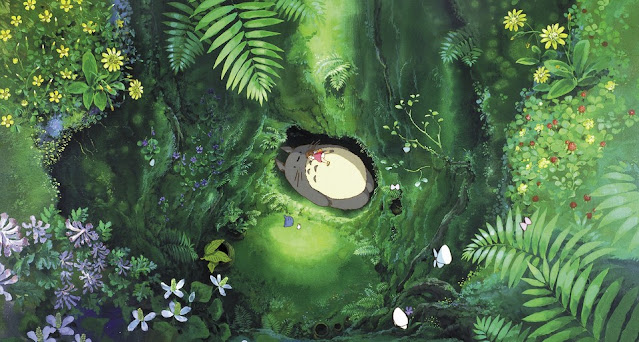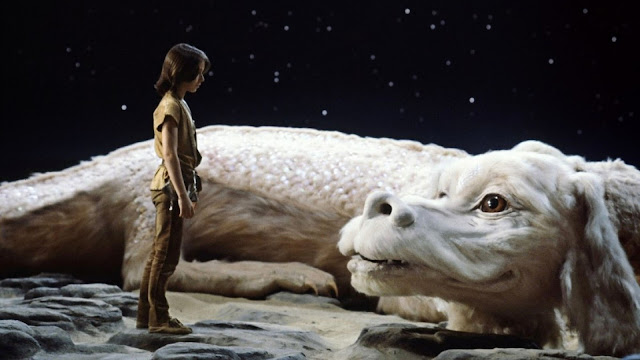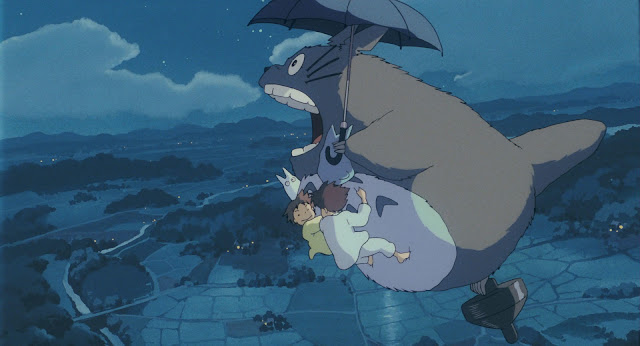This review is going to contain minor spoilers for the two films mentioned so if you wanted to watch them and feel like this would ruin the experience for you, then here is your warning to stop reading and go and watch the films.
*
It's hard to be an adult when you feel like a very tall child. Moreover, it's hard being an adult who can't seem to relate to much media created for adults. When there is no hope in sight, trust the adult brain to put its characters through hell to express how awful the world is. I think that's why I retreat to "children's media" so often: because that's where hope is. That's where overcoming your problems is both difficult and rewarding.
What I want to explore is when the solutions to these problems aren't as clear cut and how the texts handle that. The characters in My Neighbour Totoro (1988) and The Neverending Story (1984) both have real pain to deal with, and they both have fun adventures that feel good to experience alongside the protagonists. They are interestingly told and they resonate with adult life so well, encouraging their audiences to take on the point of view of a child as, often, these films posit that this is the best way to view the world and without this, you are stuck with the darkness and tragedy of adulthood.
 |
| Source: Studio Ghibli |
Being on the cusp of adolescence, childhood is presented as infinitely more appealing, and moreover, the fantastical is presented as more comforting than what is real. In My Neighbour Totoro, Mei and Satsuki are the first characters to interact with the tiny creatures that inhabit their house when they first move in. Unlike the adults in their life, they can see the forest spirits and attribute the action in the film to them. As Colin Odell and Michelle Le Blanc argue, many of the films made under Studio Ghibli put the audience into the real world only to then demand that we 'reject our notions of physics, biology and geography' so that we may get into the mindset of a child. Where an adult may rationalise or patronisingly go along with the story, the children, along with the audience, see the true magic of the landscape. Odell and LeBlanc go on to write that these films then serve as a kind of 'adult wish fulfilment'. On top of this, YouTube creator Big Joel argues that this depature from rationality is not simply asking its audience to abandon their logic but rather grow into the fantastical as it is presented in the film; like the two girls, who may try to rationalise what is happening at first, as we are presented with more information about how the world functions, we see that the childhood interpretation of Totoro and his friends protecting and controlling the forest is the rational explanation.
The way The Neverending Story interacts with childhood is through the reading of its titular book, drawing on what the filmmakers assume will be a memory for its adult audience, that of being read bedtime stories as a child. Bastian is explicitly told by his father to stop daydreaming and start facing his problems. And Bastian only takes this advice in a half measure, by using the book of 'The Neverending Story' as a way to act out reality in a controlled and magical way. Where the real world feels chaotic and painful, the land of Fantasia has pain that can easily be defeated through perseverance, insisting to its audience that a return to childhood, to our pasts (even if those pasts never really existed) can be a good map for how to handle the real world. This is what Todd Gilchrist interprets as an 'empowering' action on Bastian's part, where he uses fiction as a practical guide on 'how [to] cope with adversity'. The mind of this child has such great power that he is changing the story as he goes along, and he's the only one who can save the world in the end.
 |
| Source: Cinema Autopsy |
The symbols in the two films for escapism are Totoro, a large forest spirit, and Atreyu, a Native American boy. They are coping mechanisms for Mei, Satsuki and Bastian, where the characters can project their pain onto them and then appropriately deal with it in a way that may not be socially acceptable to those around them. For Mei and Satsuki, Totoro becomes a way for them to process the concept that their mother could die, and that they would have no control over that. Not only does he help them grow a tree and wait with them at the bus stop, he provides levity where their father cannot. YouTube channel The Take interprets Totoro as a comfort creature that brings an element of silliness to the girls' lives allowing to them to momentarily escape from a serious situation. He allows for healthy and productive forms of emotional expression, often depicted through loud roaring, which both of the girls imitate.
For Bastian, the physical book, as Brendan C. Walsh argues, becomes 'a coping mechanism of sorts that allows [him] to deal with the great psychological challenges facing [him]', this being the recent death of his mother. Atreyu is a conduit through which he can channel his pain into action. When Atreyu's horse sinks into the swamp, he is devastated. In contrast to Bastian's real life situation, where he is told to not talk about how he's feeling, Atreyu encounters two gnomes who heal his physical wounds and tell him that it is necessary for him to express where his pain is if he's going to heal. Atreyu's body and the physicality of pain maps onto Bastian's grief, for what is a very traditionally masculine expression of hurt, that which can be physically seen. Still, this is significant in that he has an avenue to express himself at all. Gilchrist explains that the book becomes a 'safe, instructional place for Bastian to explore his own fears about loss as everyone else seems to look on with indifference'.
 |
| Source: Time Out |
Both films express a reverence for the natural and a preservation of this in the face of tragedy. We see early examples of this in Totoro, how Tatsuo teaches his daughters to thank the camphor tree and its spirits for protecting Mei when she got lost. What the film does is give nature a physical form. Odell and Le Blanc argue that the environment in the film is shown to be 'a living collection of interconnected beings that should be respected', rather than a stationary object. We see that Totoro and the other spirits are the ones who are responsible for the trees growing. Along with the cat-bus, they are also responsible for the great gusts of wind, that which take the characters flying over their home so they can see the scope of where they live in relation to the forest. Odell and Le Blanc interpret this as Totoro giving the girls access to an 'unrestricted freedom' not available to them in every-day life, either in a literal sense of being children or in an emotional sense due to their despair. Though not as explicit as Princess Mononoke (1997), this film expresses a respect for the natural, infusing it with magic that the real world seems to be lacking. What's more, it invites the audience to not just see the wind blowing and plants sprouting out of the ground, but actual action, work put in by creatures.
Similar to this, The Neverending Story presents us with an expansive world being devoured by a force called The Nothing. The Nothing can be interpreted in many ways, most obviously as a metaphor for Bastian's grief, but it's hard when you see the natural world being torn up not to view it as some kind of environmental disaster, which the inhabitants of this place seem wholly powerless to stop. By evoking the name of his mother, which could be interpreted as Mother Nature, Bastian is able to restore the world to what it once was. Walsh argues that the natural landscapes become the point where 'the boundary between the materialistic and spiritual realm becomes blurred', and this is most evident when Bastian takes Falcor into the real world. We see Fantasia in opposition to New York but we also see that these elements become blended together when, at the end of the film, Bastian flies through New York on Falcor. Inviting his childhood into the industrialised adult world, Bastian is also inviting in elements of the natural landscape, that which is similarly infused with magic in the way that Totoro is. Walsh, in a similar way to Totoro, explains that flight becomes 'synonymous with imagination and creativity', championing the freedom that comes with leaning into your childhood.
I feel like these films have resonated with me so well, despite watching them for the first time as an adult, is because they offer a form of escapism that doesn't feel mindless. The intentional creation of these worlds allows them to feel real even when they seem fantastical and absurd. The world of these films asks us to see the physicality behind the randomness of our lives and through doing that, gives its characters and its audience a way of coping with their pain in an unconventional way.
Sources:
Brendan Myers, 'Fictive Metaphysics, The Neverending Story, and The Nothing', The North West Passage <http://www.brendanmyers.net/blog/2015/04/fictive-metaphysics-the-neverending-story-and-the-nothing/> [accessed 15/04/2021]
Colin Odell and Michelle Le Blanc, Studio Ghibli: The Films of Hayao Miyazaki and Isao Takahata, 3rd edn (Harpenden: Kamera Books, 2019).
'My Neighbour Totoro: What's Real?', Big Joel <https://www.youtube.com/watch?v=CpAMWsxjgYw&list=PLaGIkGWlfb3CSp5BxeBtxn-scGhJu1dpy&index=3> [accessed 15/04/2021]
'My Neighbour Totoro: Why We Need Totoro', The Take <https://www.youtube.com/watch?v=Q3EIoM3w_x0&list=PLaGIkGWlfb3CSp5BxeBtxn-scGhJu1dpy&index=2> [accessed 15/04/2021]
Todd Gilchrist, 'How THE NEVERENDING STORY Tackles Our Realest Childhood Fears', Nerdist <https://nerdist.com/article/the-neverending-story-takes-on-real-childhood-fears/> [accessed 15/04/2021]